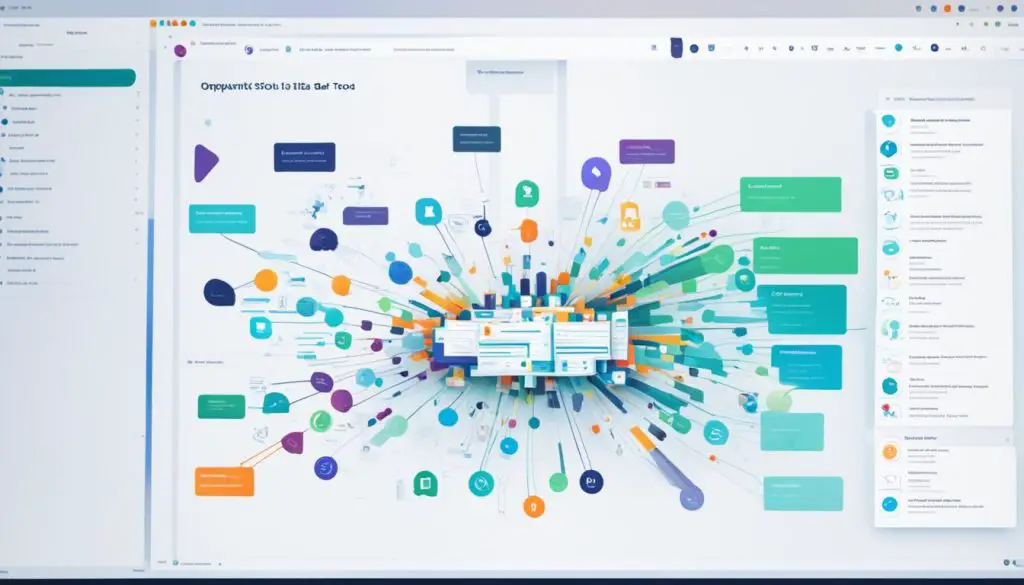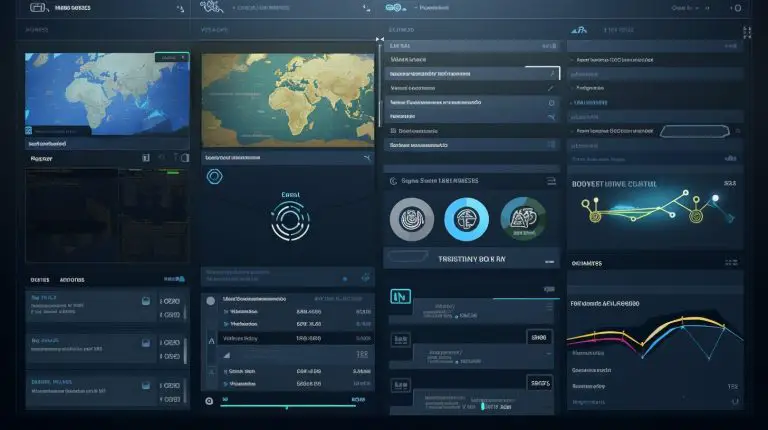OSSIM Explained: Unlocking Open Source SIEM Insights
Welcome to my article on OSSIM, the powerful open-source Security Information and Event Management (SIEM) platform. In this comprehensive guide, we will delve into the definition and features of OSSIM, explore its benefits, usage, integration options, and its capabilities. By the end of this article, you will have a clear understanding of OSSIM’s technology and how it can enhance your cybersecurity defenses.
Key Takeaways:
- OSSIM is an open-source SIEM platform.
- It offers essential security capabilities such as asset discovery, vulnerability assessment, and SIEM event correlation.
- OSSIM leverages the power of Alien Labs Open Threat Exchange (OTX) to provide real-time information about malicious hosts.
- It is cost-effective, customizable, and has a strong community support system.
- OSSIM can be seamlessly integrated with various third-party tools and technologies.
What is OSSIM and How Does it Work?
OSSIM, or AlienVault OSSIM, is a leading open-source Security Information and Event Management (SIEM) platform that combines security event management (SEM) and security information management (SIM) functionalities. As a SIEM tool, OSSIM plays a crucial role in enhancing an organization’s cybersecurity posture by collecting and aggregating log data from various sources within the technology infrastructure.
But how does OSSIM work exactly? Let’s take a closer look at its functionality:
- OSSIM continuously collects and analyzes data from sources such as firewalls, intrusion detection systems, and antivirus software.
- This data is securely stored, allowing the platform to maintain a comprehensive record of security events and incidents.
- OSSIM performs event correlation to identify any patterns or relationships within the collected data.
- The platform uses built-in analytics capabilities to analyze the data and detect potential security issues or threats.
- Based on its analysis, OSSIM generates alerts and notifications, allowing security teams to respond promptly to any identified threats.
- OSSIM also provides dashboards and customizable reports to give organizations a clear and organized view of their security posture.
This process of data collection, storage, analysis, and reporting helps organizations gain valuable insights into their security landscape. By leveraging OSSIM’s comprehensive functionality, businesses can proactively detect and mitigate security risks, strengthen their defenses, and respond effectively to incidents.
With its powerful data analysis capabilities, OSSIM empowers organizations to make informed decisions and take proactive measures to protect their valuable digital assets. By providing a unified and centralized view of security events and risks, OSSIM enables security teams to effectively monitor, manage, and respond to potential threats.
Benefits of OSSIM
OSSIM, as an open-source Security Information and Event Management (SIEM) platform, brings numerous advantages to organizations. Its cost-effectiveness, customizability, community support, and transparency make it a compelling option for businesses of all sizes.
- Cost-effectiveness: One of the key benefits of OSSIM is its cost-effectiveness. Being an open-source solution, OSSIM eliminates the need for licensing fees, allowing organizations to allocate their resources more efficiently.
- Customizability: OSSIM offers a high level of customizability, enabling organizations to tailor the platform to meet their specific security needs. This flexibility allows for the creation of a SIEM solution that aligns precisely with an organization’s requirements.
- Community Support: OSSIM benefits from a strong community support system. With a thriving user base and an active community, organizations can tap into a wealth of resources, guidance, and collective knowledge to enhance their implementation and usage of OSSIM.
- Transparency: The open-source nature of OSSIM ensures transparency and potentially more secure software. With the code available for review by the community, security vulnerabilities can be identified and addressed promptly, making OSSIM a reliable platform for organizations concerned about their cybersecurity defenses.
With OSSIM’s numerous benefits, organizations can establish a cost-effective and customizable SIEM solution while leveraging the support of a vibrant community and benefiting from the transparency inherent in open-source software.
Open Source vs Commercial SIEM Tools
When considering the choice between open-source SIEM tools like OSSIM and commercial SIEM options, there are important factors to consider. Open source tools, while cost-effective, may come with their own set of drawbacks. They can pose potential security risks and require more manual effort for installation and maintenance. Additionally, they may not offer the same level of support and comprehensive capabilities as commercial SIEM tools.
On the other hand, commercial SIEM solutions provide significant advantages. They offer ongoing customer support, ensuring that organizations have the assistance they need when facing any issues or challenges. Commercial SIEM tools also come equipped with advanced functionalities to meet the evolving cybersecurity needs of businesses. With compliance with industry standards as a priority, commercial SIEM solutions provide in-depth protection against potential threats.
Furthermore, commercial SIEM tools offer easier integration with existing systems, allowing organizations to leverage their current infrastructure effectively. Integration capabilities ensure seamless communication between different security technologies and provide a unified view of an organization’s security posture. This makes commercial SIEM solutions the preferred choice for organizations seeking robust cybersecurity solutions that align with their specific requirements.
While open-source SIEM tools have their merits in terms of cost-effectiveness and customizability, they may not always provide the level of support and comprehensive capabilities that commercial SIEM tools offer. To make an informed decision, organizations should consider their cybersecurity requirements, the level of support needed, and the desire for ease of integration.
Key Features of OSSIM
When it comes to enhancing cybersecurity, OSSIM offers a range of key features that provide organizations with the necessary tools and capabilities to protect their networks. Let’s explore these features in more detail:
-
Asset Discovery
OSSIM’s asset discovery feature enables organizations to identify and inventory devices and software within their network. This comprehensive view of network assets helps maintain a complete and up-to-date understanding of the organization’s infrastructure.
-
Vulnerability Assessment
With OSSIM’s vulnerability assessment functionality, organizations can identify potential weaknesses within their network and infrastructure. This critical capability aids in prioritizing security efforts and implementing necessary measures to mitigate vulnerabilities.
-
Intrusion Detection
OSSIM’s intrusion detection feature plays a crucial role in identifying and responding to malicious activities in real-time. By monitoring network traffic and system logs, OSSIM can detect signs of unauthorized access, malware infections, and other security breaches.
-
Behavioral Monitoring
OSSIM’s behavioral monitoring functionality monitors user behavior and network activity patterns to identify anomalous activities. By establishing baselines and detecting deviations, organizations can quickly detect potential insider threats or abnormal behavior that may indicate a security incident.
-
SIEM Event Correlation
OSSIM’s SIEM event correlation capability allows organizations to analyze and correlate security events from various sources. This feature enables the identification of complex attack patterns, threat indicators, and possible security breaches by aggregating and correlating events across the network.
These features collectively empower organizations to enhance their security visibility, detect and respond to threats in a timely manner, and maintain a strong defense against cyberattacks.
Integration and Compatibility with OSSIM
OSSIM offers seamless integration with various third-party tools and technologies, making it a versatile platform for enhancing cybersecurity. Organizations can leverage their investments in other cybersecurity solutions by integrating OSSIM with existing systems.
OSSIM also provides integration with ticketing software such as JIRA and ServiceNow, streamlining the incident response and ticket management processes. By integrating OSSIM with these ticketing software tools, organizations can enhance their incident tracking and resolution capabilities.
The integration capabilities of OSSIM enable organizations to consolidate their security operations, improve efficiency, and enhance overall cybersecurity. Whether it’s integrating with endpoint security solutions, network monitoring tools, or vulnerability management systems, OSSIM ensures compatibility and efficient collaboration between different cybersecurity components.
“The seamless integration capabilities of OSSIM enable organizations to consolidate their security stack and enhance overall cybersecurity.”
OSSIM’s compatibility with third-party tools not only simplifies the implementation process but also allows organizations to choose the best-of-breed solutions for their specific security needs. By integrating different tools with OSSIM, organizations can create a comprehensive security ecosystem that provides enhanced threat detection, incident response, and vulnerability management capabilities.
Key benefits of OSSIM integration:
- Streamlined incident response and ticket management processes
- Improved collaboration between different cybersecurity components
- Enhanced threat detection and mitigation capabilities
- Efficient utilization of existing cybersecurity investments
- Flexible integration with various third-party tools and technologies
With its compatibility and integration capabilities, OSSIM empowers organizations to build a robust and interconnected cybersecurity infrastructure that addresses their unique security requirements.
OSSIM Deployment Options
When it comes to deploying OSSIM, organizations have multiple options to choose from based on their specific requirements. OSSIM offers both on-premises deployment and cloud deployment, providing flexibility and control over the security infrastructure. Let’s explore these deployment options in detail:
On-Premises Deployment
For organizations that prefer complete control over their security environment, OSSIM supports on-premises deployment. This allows the installation of OSSIM in both physical and virtual environments, giving organizations the freedom to tailor the deployment to their specific needs.
With on-premises deployment, organizations can manage and secure their data within their own infrastructure. This offers a higher level of control and allows for seamless integration with existing security tools and systems already in place within the organization.
Cloud Deployment
OSSIM also provides support for cloud deployment, catering to organizations leveraging the power of cloud computing. By deploying OSSIM in cloud environments such as AWS and Azure, organizations can take advantage of the scalability and flexibility offered by these platforms.
Cloud deployment allows organizations to eliminate the need for maintaining physical infrastructure, reducing hardware costs and operational overhead. Additionally, it enables organizations to easily scale their security infrastructure as their needs evolve, ensuring optimal performance and adaptability.
Whether an organization chooses on-premises deployment or cloud deployment, OSSIM’s deployment options make it suitable for various IT environments. This flexibility allows organizations to select the deployment method that aligns with their unique requirements and security strategy.
Learn more about OSSIM deployment options and find the approach that best fits your organizational needs and IT infrastructure. Deploying OSSIM will help you take control of your security environment and enhance your cybersecurity defenses.
I chose OSSIM’s on-premises deployment option as it provided us with complete control over our security infrastructure and seamless integration with our existing tools. It allows us to manage and secure our data according to our specific requirements. – Richard Johnson, CTO at XYZ Corp
Cloud deployment of OSSIM was a game-changer for us. It provided the scalability and flexibility we needed to adapt to our dynamic IT environment. With OSSIM in the cloud, we were able to focus more on our core business while ensuring the security of our data. – Emily Roberts, Chief Information Security Officer at ABC Inc.
OSSIM vs USM Anywhere
When comparing OSSIM and USM Anywhere, we can see some notable differences between these two SIEM solutions. While OSSIM is an open-source platform, USM Anywhere is a commercial offering provided by AlienVault. Each solution has its own strengths and features that cater to different organizational needs. Let’s explore the unique capabilities of both SIEM tools.
OSSIM: Open-Source Flexibility
OSSIM, also known as AlienVault OSSIM, is a widely used open-source SIEM platform. It provides a range of essential security capabilities, including asset discovery, vulnerability assessment, intrusion detection, behavioral monitoring, and SIEM event correlation. With OSSIM, organizations benefit from the transparency and customizability that open-source solutions offer. It can be tailored to meet specific security requirements and integrated with other cybersecurity tools.
USM Anywhere: Comprehensive Commercial Solution
USM Anywhere, on the other hand, is a commercial SIEM solution that offers more advanced functionality and features. It provides centralized threat detection and incident response across cloud environments, on-premises infrastructure, and cloud apps. USM Anywhere also includes log management for ongoing compliance and forensics investigations, advanced threat detection capabilities, and pre-built compliance reports. With this comprehensive and fully supported SIEM solution, organizations can have peace of mind knowing they have a robust cybersecurity platform in place.
Choosing the Right SIEM Solution
When deciding between OSSIM and USM Anywhere, organizations should consider their specific needs and priorities. OSSIM’s open-source nature provides flexibility and customization options, while USM Anywhere offers comprehensive functionality and support. Factors such as budget, resource availability, and the level of technical expertise within the organization should be taken into account when making a decision. Ultimately, the choice between OSSIM and USM Anywhere will depend on the unique requirements and goals of each organization.
Considerations for Choosing SIEM Tools
When selecting a SIEM tool, there are several factors to consider. Organizations should carefully evaluate these factors to ensure they choose the right SIEM tool that aligns with their specific needs and requirements.
Deployment Options
One essential consideration is the deployment options offered by the SIEM tool. Organizations should assess whether the tool supports on-premises deployment, cloud-based solutions, or both. This evaluation is crucial to ensure compatibility with their existing IT infrastructure and the level of control they require over their security environment.
Vendor Support
The level of support provided by the SIEM tool vendor is another critical factor to consider. Ongoing customer support can significantly impact the effectiveness and efficiency of using the tool. It is vital to evaluate the vendor’s track record in terms of responsiveness, expertise, and availability of support resources. Reliable support can help organizations address any issues or challenges they may encounter during deployment, operation, or maintenance of the SIEM tool.
Capabilities and Features
The capabilities and features of the SIEM tool should align with the organization’s cybersecurity requirements. It is essential to assess the tool’s ability to detect threats, analyze log data, provide real-time alerts and incident response, and assist with regulatory compliance. Organizations should review the tool’s reporting capabilities, integration options with other security solutions, and its scalability to accommodate future growth and evolving security needs.
Scalability and Performance
Organizations should consider the scalability and performance of the SIEM tool, especially if they anticipate expanding their infrastructure or face high-volume data log collection. The tool should be able to handle increased data volume without compromising performance, ensuring timely detection and analysis of security events.
Cost and Return on Investment (ROI)
Cost is often a significant factor in decision-making. Organizations should evaluate the initial investment required to implement the SIEM tool, including any licensing or subscription fees, as well as ongoing operational costs. It is crucial to assess the potential return on investment (ROI) and cost-effectiveness of the tool by considering its ability to enhance security, streamline incident response, and reduce the impact of cybersecurity incidents.
By carefully considering these factors, organizations can make an informed decision in choosing the right SIEM tool that aligns with their specific needs, enhances their cybersecurity capabilities, and provides a strong security posture.
Top Open Source SIEM Tools
In addition to OSSIM, there are several other open-source Security Information and Event Management (SIEM) tools available, providing businesses with alternative choices when considering SIEM solutions. These top open-source SIEM tools offer a range of features and capabilities that enhance cybersecurity.
1. Wazuh
Wazuh is a robust open-source SIEM tool that originated as a fork from OSSEC. It offers powerful log analysis and rootkit detection capabilities, allowing organizations to identify potential security threats and respond effectively.
2. ELK Stack (Elasticsearch, Logstash, Kibana)
The ELK Stack, comprised of Elasticsearch, Logstash, and Kibana, is a popular open-source SIEM solution known for its powerful log analysis capabilities. Organizations can leverage this stack to collect, process, and visualize log data, enabling effective threat detection and incident response.
3. Prelude
Prelude is a universal SIEM system that offers real-time monitoring, log analysis, and event correlation. It provides comprehensive security visibility and enables organizations to proactively detect and respond to security incidents.
4. Graylog
Graylog is a log management platform that can be transformed into a SIEM tool. It offers centralized log collection, analysis, and visualization capabilities, allowing organizations to gain insights into their security posture and detect potential threats.
These open-source SIEM tools, including OSSIM, Wazuh, ELK Stack, Prelude, and Graylog, provide organizations with the flexibility, customization, and cost-effectiveness of open-source solutions while enhancing their cybersecurity defenses.

Conclusion
In conclusion, OSSIM is a widely used open-source Security Information and Event Management (SIEM) platform that provides organizations with essential security capabilities, integration options, and customization potential. As an open-source solution, OSSIM offers cost-effectiveness and the flexibility to tailor the platform to specific requirements. However, it is important to note that open-source SIEM tools like OSSIM may require more hands-on effort for installation and maintenance and may lack certain commercial features and support.
When choosing a SIEM solution, organizations should carefully evaluate their specific needs and consider the benefits and drawbacks of both open-source and commercial options. While OSSIM offers extensive features and community support, commercial SIEM tools provide ongoing customer support, advanced functionalities, and compliance with industry standards. The decision should be based on the organization’s budget, resources, and desired level of support.
Nevertheless, OSSIM remains a valuable option for organizations looking to enhance their cybersecurity defenses. Its array of security capabilities, integration abilities, and community support make it a reliable choice for businesses of all sizes. By leveraging OSSIM, organizations can bolster their security posture and gain valuable insights into potential threats and vulnerabilities.
FAQ
What is OSSIM?
OSSIM stands for AlienVault Open Source Security Information and Event Management (SIEM). It is an open-source platform used for collecting and analyzing log data from various sources within an organization’s technology infrastructure.
What are the features of OSSIM?
The key features of OSSIM include asset discovery, vulnerability assessment, intrusion detection, behavioral monitoring, and SIEM event correlation.
What are the benefits of using OSSIM?
Some of the benefits of using OSSIM are its cost-effectiveness, customizability, robust community support, and transparency due to its open-source nature.
How does OSSIM differ from commercial SIEM tools?
OSSIM, being an open-source SIEM tool, is cost-effective and customizable. However, commercial SIEM tools offer more advanced functionalities, ongoing customer support, and easier integration with existing systems.
What are the key features of OSSIM?
The key features of OSSIM include asset discovery, vulnerability assessment, intrusion detection, behavioral monitoring, and SIEM event correlation.
Can OSSIM integrate with other third-party tools?
Yes, OSSIM can be seamlessly integrated with various third-party tools and technologies, allowing organizations to leverage their existing cybersecurity solutions.
What are the deployment options for OSSIM?
OSSIM can be deployed on-premises in physical and virtual environments, as well as in cloud environments like AWS and Azure.
How does OSSIM compare to USM Anywhere?
OSSIM is an open-source SIEM platform, while USM Anywhere is a commercial SIEM solution offered by AlienVault. USM Anywhere provides more advanced functionality and comprehensive support.
What should organizations consider when choosing a SIEM tool?
Organizations should consider factors such as deployment options, level of support, and the capabilities of the SIEM tool when making a selection.
What are some other open-source SIEM tools available?
Some other open-source SIEM tools include Wazuh, ELK Stack, Prelude, and Graylog.
- About the Author
- Latest Posts
Mark is a senior content editor at Text-Center.com and has more than 20 years of experience with linux and windows operating systems. He also writes for Biteno.com



